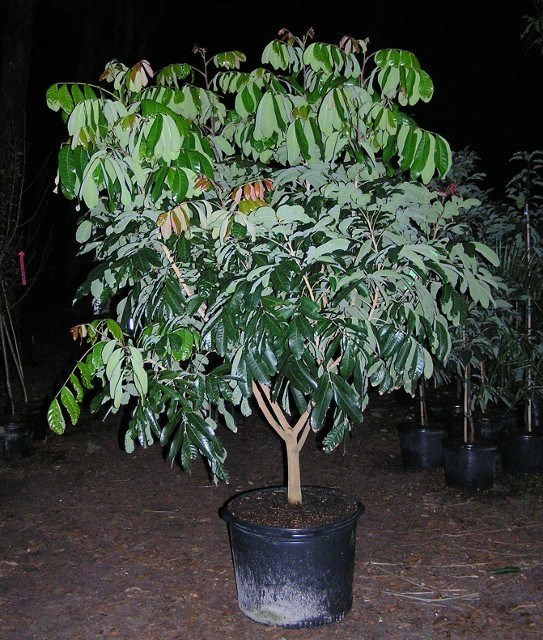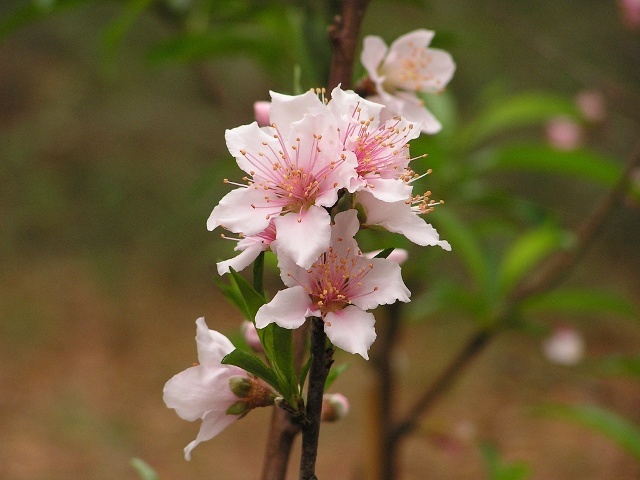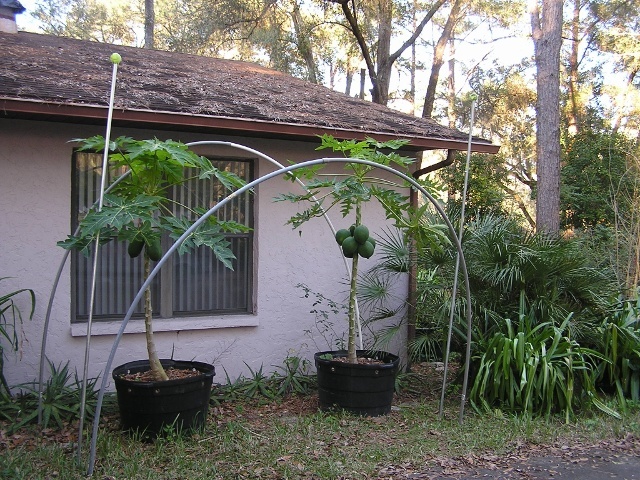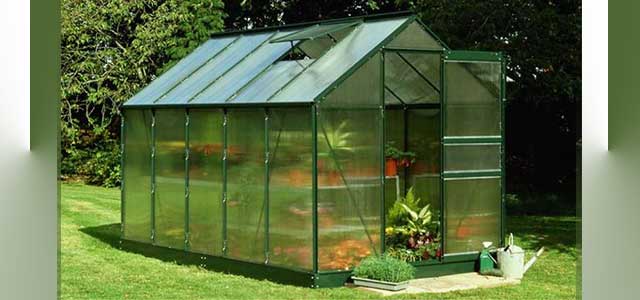So When Should I Cover My Plants?
If you're new to the area, or new to growing stuff, it can be a daunting task to learn when to cover your fruiting plants and when not. And it is challenging to sort through the language used to describe "cold hardy" since it all depends on the perspective of the writer -- welcome to the world of gardening!
Most all of the fruiting trees will begin to go dormant when the temperatures start dropping below 45-50° at night. For a "sub-tropical" plant, that is a very necessary part of its life cycle. It NEEDS a certain number of hours below 45° to re-set its biological clock, go dormant, and start making blossoms again in the spring. Without this period of dormancy, you would get no blossoms and no fruit. So we don't cover them: they NEED the cold.

When should I cover my plants?

6' tall / 30g Longan
Now, "tropical" fruiting trees will go dormant too as the temperatures drop under 50-60° --- it will vary a bit, but generally at 50°. So when they are grown in their native environment, they grow fast, luscious, and are evergreen year around -- mostly. But when grown in a sub-tropical environment like zone 9, you will have different behavior than their "norm". You will see 3 months or so of dormancy, and perhaps a sudden leaf drop that lasts all of a few weeks, instead of just a gradual unnoticed replacement of leaves throughout the year. And you will likely have shorter plants at maturity than when found in their native habitat.
So "when to cover" a tropical plant is determined by what your goals are: Are you wanting optimal growth, no dormancy, and fruit year-around? or just normal growth for this area and keep the plant alive and healthy for next year's crop? For the wholesale grower, they go with option 1: keep it from going dormant because it needs to be retail-ready always. For the home orchardist, we tend to choose option 2: keep it practical!
Here's two generalities to go by:
As a general rule of thumb, anything that is considered a "sub-tropical" plant should not need frost protection in any of zone 9, PROVIDED you got the right advice on what kind to plant.
Anything that is considered a tropical plant is going to start dormancy at about 50°, but is generally not sensitive to losing foliage until we get frost at 32°.

peach blossoms in February
Fruit trees that NEVER need freeze protection:
When planted in their correct zones, these fruiting trees, bushes and vines should never need frost protection in zones 8b & 9 (down to 15-18°):
- peaches
- plums
- nectarines
- pears
- apples
- persimmons
- figs
- pomegranates
- loquats
- native black mulberries
- jujube
- tea plant
- tea olives
- kiwi vines
- muscadine grapes
- blackberries
- thornless raspberry: Itsaul 'Summer'
- pineapple guava
- blueberries
- purple passion fruit
For citrus: Chinese Honey Oranges (Ponkan Tangerine), Satsuma oranges, Hamlin oranges, Kumquats, and Meyer Lemons are all considered hardy to 15-18 degrees as well, at 10g size and up. Pineapple Oranges, Ruby Red grapefruits and Persian Limes are hardy to 18-21°, if planted with a little wind protection and kept well fed.
Nuts that never need protecting here: Pecans, Chestnuts, Black Walnuts and Hazel nuts / Filberts.
A Few Nuances Explained:
Sometimes you hear of peaches losing their fruit to the freeze: that only happens when you have an unexpected extremely late freeze in April, and usually not in these parts of Florida. Our low chill cultivars should tolerate a late light freeze, provided your particular variety is not planted on the northern edge of its grow zone.
For example: A Tropic Beauty is a 150 chill hour peach. It is meant for Tampa, St Pete, Orlando and further south: zone 9b. If you plant it in Gainesville, the tree will grow here but there is a probability that a late freeze will wipe out the fruit set.
Last year we got fruit on our Tropic Beauty in Gainesville: highly unusual. In Gainesville we need a tree that is at least 200 chill hours, and if we err on the side of 300-450 chill hour types we get a more dependable harvest every year.
There are also micro niches on the north side of Orlando, and the south side of Brooksville where the same is true -- a late freeze nips the fruit on a Tropic Beauty -- yet 5 miles away the tree produces fruit reliably. In that instance, don't give up on peaches! Just choose a Florda Belle (200 chill hours), Tropic Snow (200 chill hours), or Florda Best (250 chill hours).
That said, don't be afraid to plant a Scarlett Beauty plum in Gainesville just because it says "150 chill hours". For reasons I don't pretend to understand, the Scarlett Beauty plum will set and mature fruit in ALL of zone 9, regardless of the late freeze! And the same is true of a few 150 chill hour pears too.
You just have to talk to an "old timer" or a native to know some of these nuances!
Frost protection starts in the summer:
A well fed and watered plant will develop at least 2-3 degrees more cold tolerance than an under nourished plant.
And planting your tropical on the south side of your house will afford you some wind protection, extending your plant's cold tolerance. None of the tropicals like the wind -- cold or hot, but especially cold wind.
When frost is predicted:
Begin protecting young tropicals at 34-35°. A 3g plant needs cold protection around 34-35°. A 15 gallon plant (15g) is usually ok until about 31-32°, provided the freeze doesn't last more than 1-2 hours.
For many tropicals, a 15g plant in the ground, with good wind protection -- i.e. planted on the south side of a building, fence or other low-growing evergreens -- can often tolerate quick, short durations down to 27-28°. Short durations mean 1-3 hours and back up over 40° the next day.
Fruit trees that DO need frost protection:
Mature specimens of these tropicals are usually tolerant of short durations of light frost to 28°, if afforded wind protection:
- Jaboticabas
- Sapodillas
- Longan
- Lychee
- cold tolerant avocados
- cold tolerant mangoes
- Cherry of the Rio Grande
- Black Sapote
- June plum
- Star Fruit: aka Carambola
- Sugar Apples
- yellow passion fruit
These plants are going to lose foliage at 31-32° unless protected: papayas, barbados cherries (aka Acerola cherries), grumichama cherries, miracle fruit, Strawberry Tree and coffee.
Soursop (Guanabana), Chocolate tree (Cacao / Cocoa), and Black Pepper plants must be kept over 45 degrees: At 40°, they start losing leaves and at 35° they are dead. Macadamia nut and Coconut Palms can be grown in 9b, but it is tricky to get a harvest because of the occassional cold snap -- they do not like the frost at all.
For citrus: Eureka Lemons and Key Limes are the most cold sensitive of the citrus family. Plan to protect these from any frost.
Valencia, navel and red navel oranges are also more cold sensitive than the oranges listed above: plan to protect from heavy freezes.
Protecting Bananas:
Most of our banana varieties are "root hardy" to zone 8b i.e. the Georgia border. If you want fruit in zone 9a, you do need to protect the above ground plant from freezing so that you maintain the upright stalk w/ a few leaves. Bananas need 12 leaves by September 1 to start flowering in time.
The goal is to start spring / March 1st with 3-4 leaves minimum so that you will have 12 leaves by Sept 1 --- and then it can make a blossom, picking fruit by December b/4 the normal first freezes. Bananas do ok with "wrapping" the "trunks" (like with a wire hoop filled with hay, or even just a blanket) but to preserve the leaves you need a plastic dome as discussed below.
That said, there is a large stand of bananas inside the city limits of Gainesville near the GHS high school that keeps its foliage year around and has had bananas most years since the 1970's! It all depends on the micro-niche.
Side Note On Growing and Protecting cold tolerant Avocados:
Our first year with cold-tolerant avocados was a bit of a challenge here, mostly due to a lack of proper information for these new cultivars found in Mexico. This would include these 5 varieties: Fantastic, Lila, Pancho, Brazo Belle, and Joey.
What we have learned is that these varieties need normal cold protection for an avocado until it has a minimum trunk size of 5-6" -- then it develops more bark and is more able to take the lower temperatures.
So protect your avocados below 28-32°, depending on where you have it planted. If they are blooming when the freeze hits, we could lose the crop, but they usually don't bloom until mid-February to March.
We've also found that they are more sensitive to full sun as young plants than their tropical cousins. Plant them where they can get filtered sun between 10am and 2-3pm for best results.
And all avocados are sensitive to standing water: they literally "smother" for lack of oxygen if their roots are immersed in water for more than a few hours. So the older the plant, the larger the root system, the better it will take such conditions. If you live in a flat, low area, plant your avocado up on a mounded knoll to give it better drainage. Texas growers tell us it is easier to grow the avocados in large pots until they have about 2.5-3" trunks, then put them in the ground.
About how to cover:
On any fruiting tree, it is important to remember that tender new growth will always get damaged sooner than mature leaves. And with our back-n-forth cold-hot-cold-hot in zone 9, we're going to see tender new growth out of season most years.
Personally, we go with protecting the old growth and just cut off any new growth that gets nipped --- it means less work overall to achieve good results.
When you cover stuff:
Blankets only help with wind chill and about 2-3 degrees --- only useful for very light freezes. Ideally, covering should be with plastic, creating a bubble of air underneath so that nothing is touching the leaves of the plant. If the plastic (or blanket) touches the leaves of the plant, the leaves usually get frost bit, though it may preserve the other 80% of the plant.

Bananas growing in Live Oak outdoors!

temporary greenhouse framework
over a couple of 6-7' papayas
Covering with plastic, creating an air dome will give you up to 5 degrees of advantage max, and also protects from wind chill.
Plastic also lets light reach your plants. If you can use the UV-permeable plastic, you can leave the plants covered for extended periods until the winter weather is totally past.
In severe heavy or extended freezes, you need a kind of mini-greenhouse dome over any frost sensitive plants so it doesn't touch the plants, AND you need to plan for SAFELY adding a heat source to the mini-greenhouse you've just created. I can't emphasize the safety aspect enough if you're adding a heat source!
The really good news for those of us growing tropicals in 9a, is that our 2016-2017 winter is likely to be another very mild one, according to the national weather service.
The 6-mil clear plastic on this page is what we used -- it is UV-permeable.

GothicArchGreenhouses.com have many small designs
to choose from if looking for a kit
